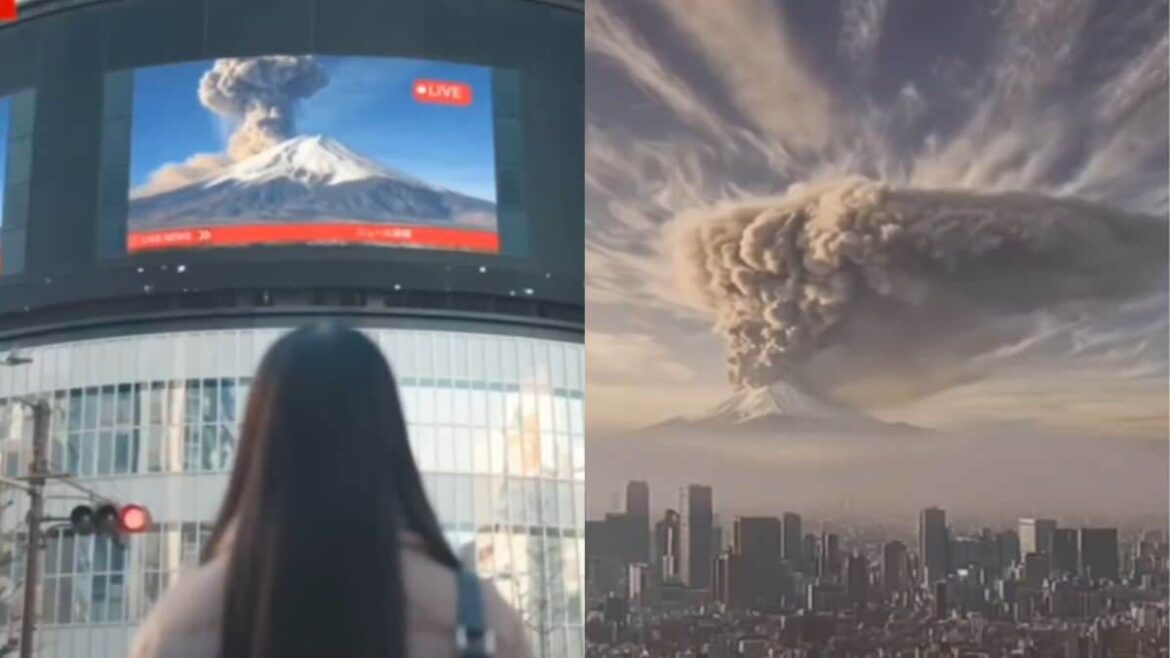Japanese officials have released an AI-generated video showing what could happen if Mount Fuji erupted. This was done to help people understand the risks and remind residents to stay prepared. The three-minute video shows how Tokyo’s transport network would be disrupted, as ash on train tracks and airport runways would bring trains and planes to a halt
Japanese officials have shared an AI-generated video imagining what an eruption of Mount Fuji could look like.
The clip shows how thick volcanic ash might bring transport and daily life in the Tokyo area to a standstill.
ALSO READ |
How Japan is turning saltwater into clean electricity
Mount Fuji, considered sacred and still an active volcano, is located about 60 miles southwest of Tokyo. It usually erupts once every 210 years.
So, what does the video reveal? And how would it affect the city?
STORY CONTINUES BELOW THIS AD
Let’s find out:
What would happen if Mount Fuji erupted?
The Tokyo Metropolitan Government released an AI-generated video last week to show what might take place if Mount Fuji erupted.
It was the first time AI had been used to help people understand the risks of a possible eruption and to remind residents to be prepared.
The video begins with huge grey mushroom clouds rising over Tokyo as the city disappears into smog.
It then shows streets and buildings covered in a heavy layer of ash while a voiceover warns: “The moment may arrive without any warning.”
🌋 Tokyo releases AI-generated video of Mount Fuji erupting..
It is all part of an artificial intelligence-generated video the Tokyo Metropolitan Government released last week to raise awareness of what could happen to the capital if Mount Fuji erupted. 🌋 pic.twitter.com/PFKKT2Rcu4
— Global𝕏 (@GlobaltrekX) August 26, 2025
“Since we do not know when Mount Fuji will erupt and blanket us with volcanic ash, to protect ourselves and our loved ones, we need to arm ourselves with facts.”
When the volcano last erupted in 1707, the blast and the ashfall went on for two weeks.
According to the video, if the volcano erupts again, ash could start falling on Tokyo within one to two hours. Between 2 and 10 centimetres of ash is expected to build up.
“Volcanic ash is made up of fine, jagged particles. Its unique qualities pose many hazards to health and society,” the video says.
STORY CONTINUES BELOW THIS AD
The three-minute clip shows how Tokyo’s transport system would be hit, as ash on train tracks and airport runways would force trains and planes to stop running.
People are urged in the video to keep enough food at home for at least three days, since public transport would be suspended and shops would quickly run out of supplies.
If it rains, wet ash building up on antennas and power lines could also trigger major power cuts and disrupt phone and internet services.
To stay safe from health risks, the video advises people to wear masks and goggles outdoors. Ash can irritate the eyes and affect breathing, especially for those with conditions such as asthma.
ALSO READ |
Japan warns of megaquake that could kill 300,000 along Nankai Trough: What is it?
What experts are saying
With around 43 million people living in the Tokyo metropolitan area, the video warns that public health would be hit hard if Mount Fuji erupted.
But some experts are doubtful.
Kimiro Meguro, professor of disaster mitigation engineering at the University of Tokyo, called the simulation “alarmist”.
He told This Week in Asia, “The simulation that is being shown would only ever happen under special conditions and this is not a high-probability event… It shows a worst-case scenario that is built on the assumption of what would happen in the event of an eruption of Mount Fuji.”
STORY CONTINUES BELOW THIS AD
Professor Takeshi Sagiya of Nagoya University told the South China Morning Post that volcanic ash could cause many unforeseen problems. He said the ash is made up of tiny bits of melted rock, similar to fine glass powder.
A government report published in March set out the possible scale of the disaster. It estimated that a major eruption could release 490 million cubic metres (17.3 billion cubic feet) of ash.
Western Tokyo could be covered by as much as 30 centimetres (12 inches) of volcanic material, while central Tokyo, Yokohama and Kawasaki might see around 3 centimetres (1.2 inches).
The report advised people to remain indoors, unless the ash built up to the point where it threatened the stability of buildings. Such a situation would be classed as a “level four” disaster.


AloJapan.com